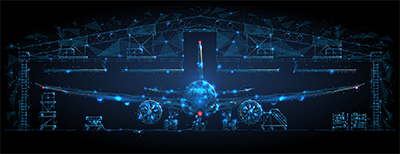 For decades, the aerospace industry has been on the cutting edge of innovation regarding automation, specifically robotics. Aerospace is now adopting machine vision technology for applications from the factory floor to the skies overhead. Mired in lengthy backorders and long lead times, the aerospace industry hopes machine vision will help it soar beyond its current challenges.
For decades, the aerospace industry has been on the cutting edge of innovation regarding automation, specifically robotics. Aerospace is now adopting machine vision technology for applications from the factory floor to the skies overhead. Mired in lengthy backorders and long lead times, the aerospace industry hopes machine vision will help it soar beyond its current challenges.
Machine Vision and Aerospace
Manufacturers have been using machine vision for decades. From product sorting to part identification to picking and packing, machine vision has made processes faster, more efficient, and more accurate than ever. By combining a camera, image processor, and software and hardware to analyze images, machines can make intelligent decisions based on what they “see.”
Machine vision has direct applications for aerospace. Experts predict the aviation computer vision market will grow to $28B in annual revenue by 2025. Whether it’s maintenance, security, or route planning, the aviation industry has one primary focus: to provide transportation as efficiently as possible while ensuring the highest safety standards.
Emerging Applications for Machine Vision
Drones and satellites create large amounts of data which takes human analysts significant time to examine for relevant information. Future drones will use computer vision for visual analysis and increased autonomy. Machine vision can comb through this data faster and lessen the time it takes to find actionable information.
Machine learning can interpret and respond to outside environments by processing data from all types of sensors, including cameras. This data shows that aircraft can be rerouted as needed without human involvement. Artificial intelligence can be used to enhance or automate targeting systems which is an important development for faster missile systems that require quicker reactions than human operators can provide.
Aerospace manufacturers and airlines need to perform inspections on their aircraft and infrastructure. Machine vision more accurately predicts failures and alerts maintenance as needed. Aviation operators can train deep learning models to find aircraft defects to improve air safety and mitigate risks.
Machine vision is effective at identifying unique people using facial recognition. Identifying passengers or threats is key to security. Humans aren’t all that needs to be identified. Baggage operations can become more efficient by counting and capturing bags and containers as they are loaded on the aircraft or sent to passengers at baggage claim.
If you’re ready to add machine vision to your automation system, contact the experts at Phase 1 Technology Corp to purchase the highest quality machine vision cameras.
